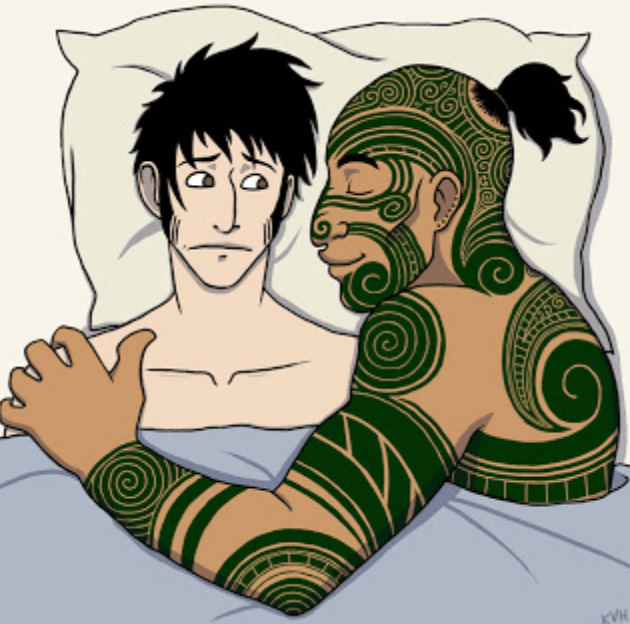I’ve always been a person to put my hand into the knotholes of trees hoping to find figures carved in soap. When I’ve encountered the rare wardrobe, I’ve reached through to the back, hoping to touch Narnia’s frostbitten fir trees. For me, rabbit holes are routes to upside-down worlds where Mad Hatters hold court, and if I could find a Platform 9 and 3/4, I’d take that train wherever it led. In Herman Melville’s Moby-Dick, Queequeg and his magical Kokovoko, a place “not down on any map” occupies the same realm for me (54). Here is this gentle giant, ferocious in appearance, benevolent in spirit, who, when he appears in the narrative, has a way of lightening the mood of the text, even as he is called a “savage” with a “cannibalistic propensity” (55). And I think it comes of his recognition that he is not apart from nature, as Ahab and the other white crew members view themselves. Queequeg is not hamstrung by a monotheistic cosmology that sets him second only to God and, so, enjoys a degree of power greater even than Ahab.
As evidence, I offer Chapter 34, “The Cabin Table,” in which the chain of command is delineated. Ishmael establishes the hierarchy of the crew by observing the order in which Ahab invites them to dine. Ahab heads to the dinner first, calling, “Dinner, Mr. Starbuck,” before entering his cabin. Starbuck extends the invitation to Stubbs and Stubbs to Flask. Ahab presides over the table like “a mute, maned sea-lion” offering beef to each officer in order of importance (122). And so rigid is the order that Flask is only allowed as many mouthfuls as he can manage before Stubb excuses himself as “it is against holy usage for Stubb to precede Flask to the deck” (122). There is no hint of the conviviality, of the fraternity that comes of a shared goal. In private moments, Flask jokes he hasn’t had a full stomach since becoming an officer. It is a short, almost innocuous scene but strangely portentous: “awful” Ahab’s disinterest in his crew heightens the narrative’s ominous tone (123).
Contrast this with the second seating for dinner in Ahab’s cabin: the harpooneers Queequeg, Tashtego, and Daggoo. These three eat with “care-free license and ease,” in an “almost frantic democracy” with “portentous appetites” (124) that require great rib racks of salted beef. And their gusto for teasing Dough-Boy seems also somehow a function of their huge appetites as does their spending as little time as possible in Ahab’s cabin or their sleeping quarters. They are creatures of the open air and the sea. They are closer to nature and the happier for it. And there is in their gusto for eating and teasing and desire to be out-of-doors the hint that they enjoy a freedom, and thus a power, that Ahab will never possess despite his having domain over The Pequod.


I love this analysis of “the Cabin Table!” I thought it was a great chapter, and I found that the personality of the characters shined through in the protocol surrounding their meals. I’m considering using this chapter as well to provide evidence for my essay which is an examination of multiculturalism aboard the Pequod and in the whaling industry.
I also find your thoughts on Queequeg and Kokovoko interesting. In reading other analyses of Queequeg and his fictitious homelands, I have seen that he is representative of all the South Pacific, but also as representative of all non-White cultures. I, personally, have him in my mind as a Maōri person, and his way of being and sense of humor are familiar to me as an Indigenous person, as something that I can relate to. I think Melville’s time on whaling ships afforded him the opportunity to get close with many other men from around the world and learn the intimate details of their culture simply by being in close proximity to them for so long. Melville also uses real family/surnames of people from the Cape and Islands which makes me think that he did not drastically change the details from his own travels. I am sure the Queequeg was a real person, though his name may have changed. It begs the question, why be so detailed in other characters with their real locations (i.e. Flask from Tisbury, Martha’s Vineyard; Tashtego from the Aquinnah Wampanoag; the Coffin and Hussey families from the Cape and Islands), and be broad and fictitious about Queequeg and his origins?